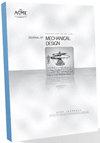Variation Analysis Method Based on Product Feature Information Network
IF 3
3区 工程技术
Q2 ENGINEERING, MECHANICAL
引用次数: 0
Abstract
Dimensional and geometric variations are significant factors of products at the manufacturing stage. Because of these variations, the physical appearance or functionality of the final product may deviate from expectations. As of the present, research on variation analysis has been conducted at the feature level. To model the information and analyze the variation transfers of products, a graphical model is constructed by using the product feature and information. Through analysis of the relationship between the product and network model, a modeling process for the feature information network is proposed. Nodes, lines, and constraints in the network are defined in detail, and the dimension unit is defined to represent the dimension information within a part. Variations caused by connections between parts are divided into two categories of influence. Combining the dimension unit and the influence between parts, a variation analysis process is devised based on the proposed network model. To verify the effectiveness and feasibility of the proposed method, a case study is performed based on the grand assembly of a hull block. The result shows that the product can be modelled and the variation can be analyzed by the proposed network model.基于产品特征信息网络的差异分析方法
尺寸和几何变化是产品制造阶段的重要因素。由于这些变化,最终产品的物理外观或功能可能会偏离预期。目前,变异分析的研究主要集中在特征层面。为了对信息进行建模,分析产品的变化传递,利用产品特征和信息构建了图形化模型。通过分析产品与网络模型之间的关系,提出了一种特征信息网络的建模过程。详细定义了网络中的节点、线和约束,并定义了尺寸单位来表示零件内部的尺寸信息。由部件之间的连接引起的变化分为两类影响。结合尺寸单元和零件之间的影响,设计了基于该网络模型的变异分析流程。为了验证所提方法的有效性和可行性,以船体块体大装配为例进行了研究。结果表明,所提出的网络模型可以对产品进行建模,并可以对其变化进行分析。
本文章由计算机程序翻译,如有差异,请以英文原文为准。
求助全文
约1分钟内获得全文
求助全文
来源期刊

Journal of Mechanical Design
工程技术-工程:机械
CiteScore
8.00
自引率
18.20%
发文量
139
审稿时长
3.9 months
期刊介绍:
The Journal of Mechanical Design (JMD) serves the broad design community as the venue for scholarly, archival research in all aspects of the design activity with emphasis on design synthesis. JMD has traditionally served the ASME Design Engineering Division and its technical committees, but it welcomes contributions from all areas of design with emphasis on synthesis. JMD communicates original contributions, primarily in the form of research articles of considerable depth, but also technical briefs, design innovation papers, book reviews, and editorials.
Scope: The Journal of Mechanical Design (JMD) serves the broad design community as the venue for scholarly, archival research in all aspects of the design activity with emphasis on design synthesis. JMD has traditionally served the ASME Design Engineering Division and its technical committees, but it welcomes contributions from all areas of design with emphasis on synthesis. JMD communicates original contributions, primarily in the form of research articles of considerable depth, but also technical briefs, design innovation papers, book reviews, and editorials.
 求助内容:
求助内容: 应助结果提醒方式:
应助结果提醒方式:


